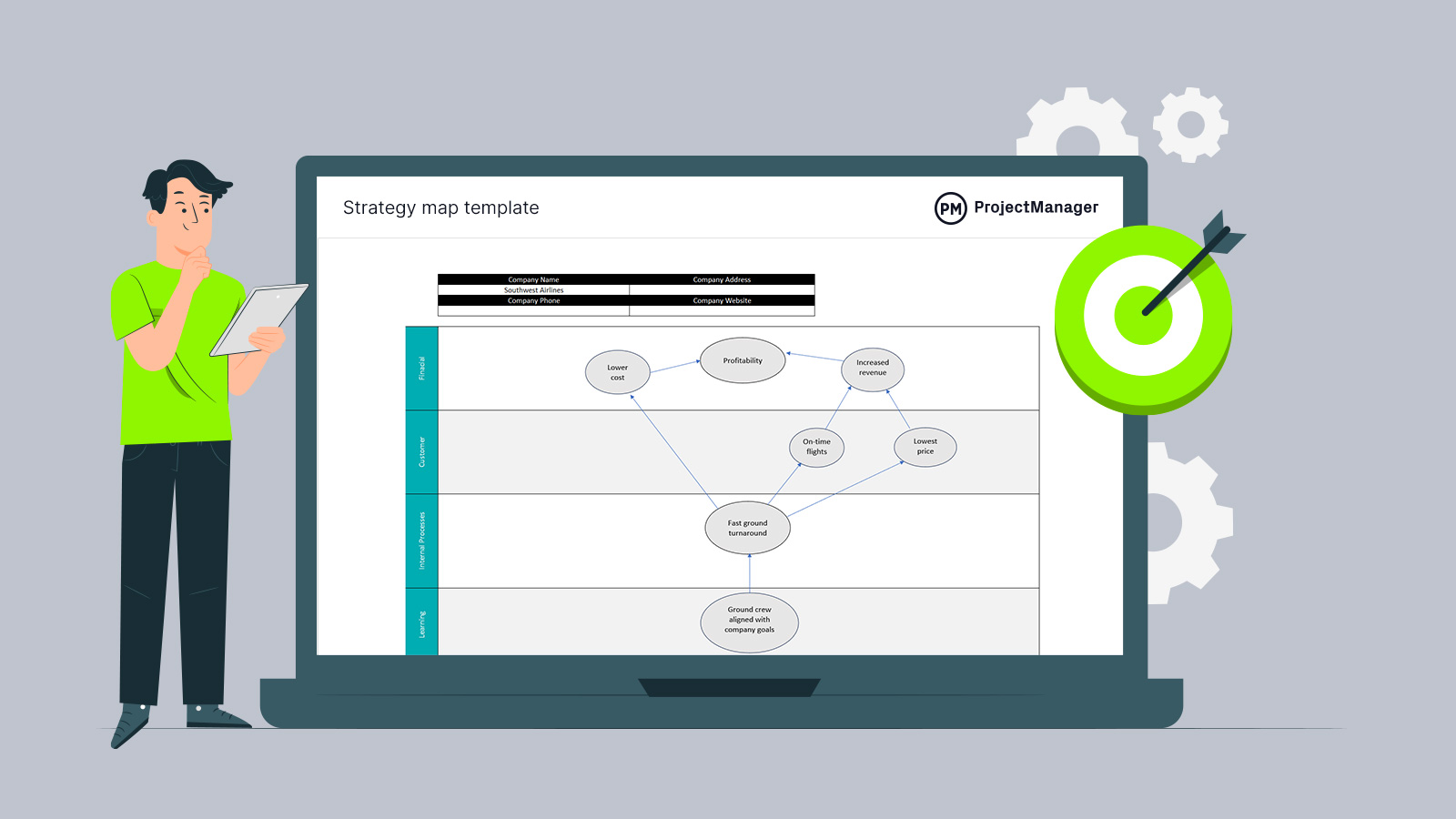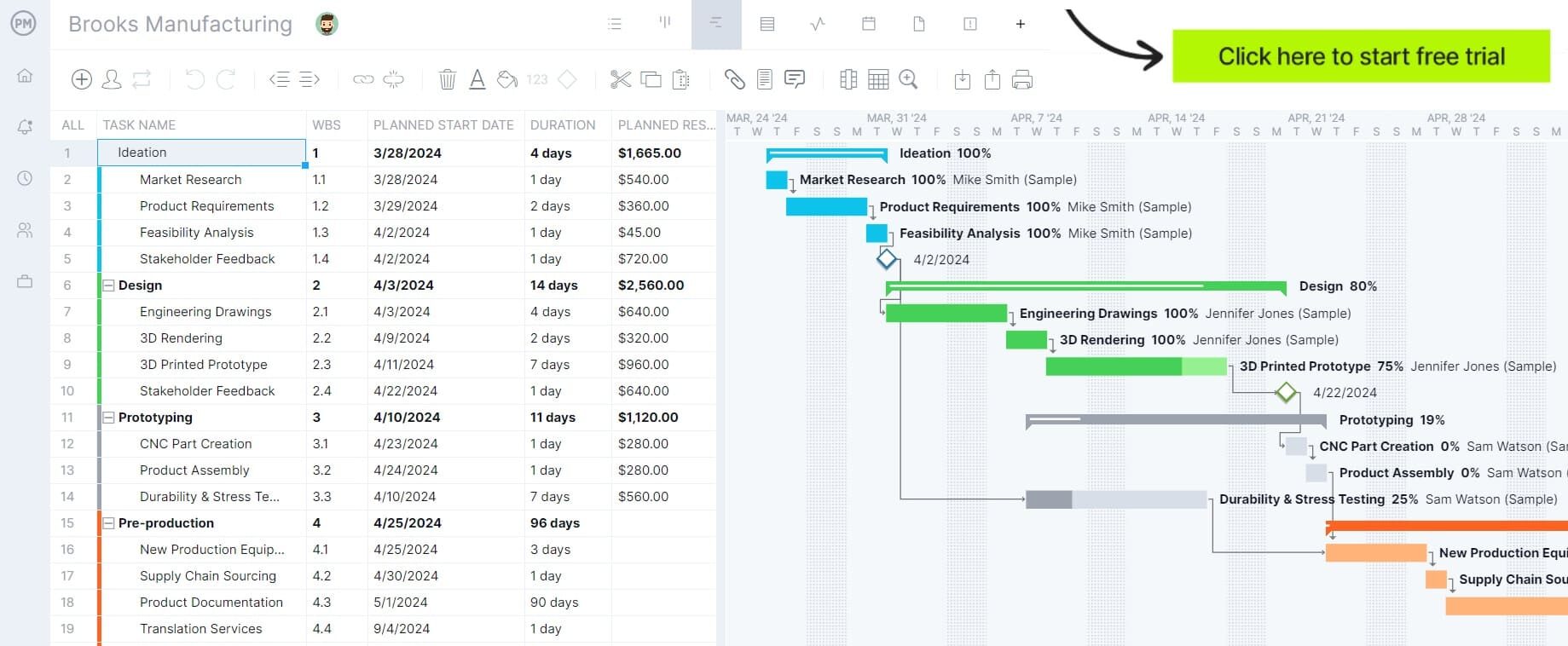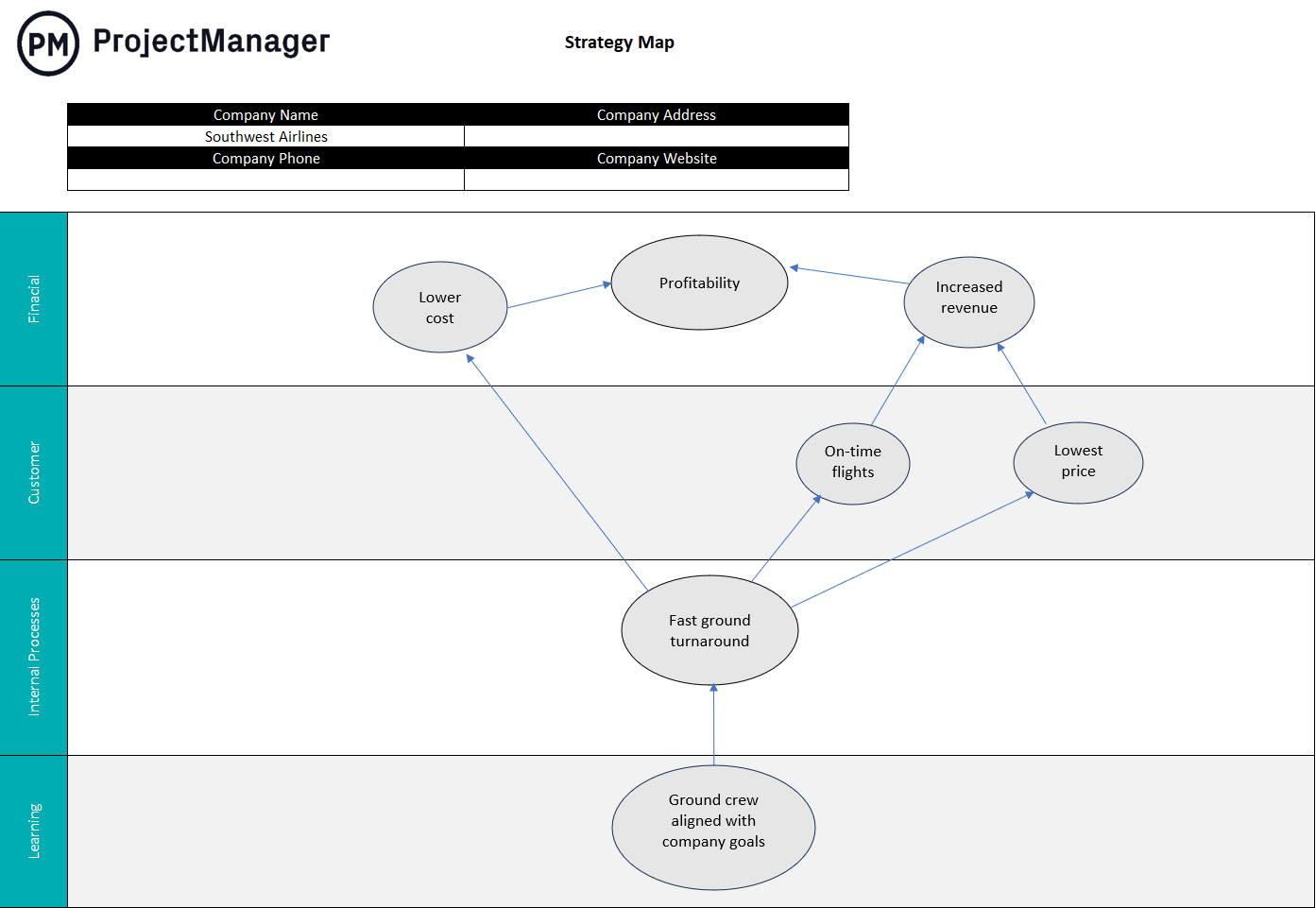Although the term “strategic initiative” might sound like inflated business jargon, it’s far from useless. A strategic initiative is a compass that guides businesses and targets future goals.
It speaks to the PMI’s A Guide to the Project Management Body of Knowledge (PMBOK), which says all projects must be strategically aligned with the organization’s business strategy.
But a strategic initiative is more than one project, it encompasses many projects working together to serve the needs of the larger corporation. Strategic initiatives are large and complex, requiring a program manager to steer that big ship.
What Is a Strategic Initiative?
A strategic initiative is a set of actions that are taken by a company toward the improvement of its operations or the completion of its strategic goals and its overall strategic plan. Strategic initiatives, also known as business initiatives or company initiatives, operate on three tiers. They have to address the company’s vision, speak to the benefits of stakeholders and work towards growing the company while aligning its various segments.
Another way to look at strategic initiatives is that it’s the instrument that helps deliver on the company’s vision. It takes the abstract and makes it practical by putting it into practice in the real world. In this definition, a strategic initiative can be a project or several interrelated projects, which is known as a program in project management.
For example, one strategic goal of a retail company might be to increase its market share by 10% in the upcoming years. One strategic initiative to achieve such goals might be to expand its distribution channels online, which would involve several projects such as creating a website and establishing a logistics management framework to support its online operations. These strategic goals and initiatives are usually documented on a strategic plan, which is a document that explains what a business is set to achieve in the next three to five years.

Get your free
Strategy Map Template
Use this free Strategy Map Template for Excel to manage your projects better.
Why Make a Strategic Initiative?
Organizations will want to develop strategic initiatives because it gives them a way to achieve specific objectives. It can also be a means to close the gap between the target of a program and its current performance.
Strategic initiatives are also helpful for executives who want to have a framework by which they can review all their projects in the program, define various impacts on the program and then focus on only those projects that can deliver immediate and measurable changes.
It’s all about improving the way an organization operates. Strategic initiatives are not about remaining complacent: they seek to get the greatest return out of the various projects in your portfolio.

Types of Strategic Initiatives
Strategic initiatives are used to develop and execute strategies to achieve business goals across several disciplines. Below is just a sampling of how strategic initiatives can help various enterprises.
Corporate-Level Strategic Initiatives
This is the highest level of management in an organization and will affect the entire organization’s direction. Corporate-level strategy is a comprehensive analysis companies use to plan for the future. It includes financials, employees, management and goals, all of which will lead to achieving long-term objectives.
Business-Level Strategic Initiatives
This is the next level in an organization’s strategic initiative. It’s a long-term plan created to achieve a company’s goals and improve its strategic direction. These initiatives can help a company align its resources and capabilities, prioritize initiatives and drive growth. It can also help a company gain a competitive advantage and create value for its shareholders and customers.
Functional-Level Strategic Initiatives
This is where the higher-up strategic initiatives are executed. These are the actions or goals assigned to a department within a business to support its corporate and business-level strategies. The goal of a functional-level strategic initiative is to specify the outcomes that should be achieved from the daily operations of a specific department.
Offensive Strategic Initiatives
An offensive strategic initiative is a bold action that aims to help an organization gain an advantage over its competitors. The goal is to take advantage of opportunities, introduce new solutions or create market disruptions to help the organization become a leader, whether by launching a new product, entering new markets, outpacing competitors or exploiting vulnerabilities.
Defensive Strategic Initiatives
A defensive strategic initiative is used by organizations to ensure they maintain their existing advantage or market position. Such initiatives may involve new methods and strategies, but the purpose is to defend against competitors.
Corrective Strategic Initiatives
A corrective initiative is used to address existing issues in an organization and to come up with a plan to fix or remove them. These initiatives are usually short-term to allow teams to focus on larger and more complex strategic initiatives as soon as they remove the issue and that is hindering development.
How to Make a Strategic Initiative
There are five steps to a well-made strategic initiative.
Step 1: Set a Goal
Before you get started, you have to know what it is you’re starting. There are likely dozens of fronts on which you can wage your strategic initiative. But the more things you try to improve, the less likely you’ll be improving any of them.
Therefore, take the time to think about what you have the capacity to confront and the resources to execute over the long term. Boil your list of strategic initiatives down to just one that will have the most positive impact on the program or business.
Step 2: Set Objectives
As noted, objectives are specific, measurable and realistic long-term goals. This is the time to set them in the strategic initiative process. Think of them as milestones that mark the end of one phase and the start of a new one.
Step 3: Set the Strategy
This is the part when you take your objectives and figure out how you’re going to achieve them. It could be one or many ventures, such as monitoring program metrics to see where greater efficiencies can be created or training your team or sales force to produce a better product or service and get that out to a larger customer base.
Step 4: Set Up a Plan
Plans are the same, even when planning a strategic initiative. You want to start with a larger deliverable, which is your objective, and then break it down into smaller and smaller tasks, which are then given duration and placed on a schedule.
This plan should be transparent in that it’s visible for your entire project team, so everyone is working in congress. They need to know what their project roles and responsibilities are for the success of the strategic initiative.
Step 5: Execute the Plan
Once you have the strategy and the plan, you have to get the team on board. With their buy-in, the whole thing becomes a reality. They are accountable for executing the plan. Program managers will give them direction, monitor their progress and regularly meet with them to get feedback and make sure the plan is on track.
Strategic Initiatives Examples
Strategic initiatives are often better understood when illustrated by examples. Therefore, below are a handful of examples in which a strategic objective is defined and a series of initiatives are described to achieve that objective.
Professional Services Strategic Initiative
Strategic Objective: Reduce customer churn
Strategic Initiatives:
- Create a customer onboarding process to convert new customers and retain them.
- Increase customer service, respond to customer queries quickly and offer more helpful advice to improve customer experience.
- Do a deep analysis of churn data to identify and remove friction points.
- Seek customer feedback to understand issues in communication, working process, etc.
Retail Management Strategic Initiative
Strategic Objective: Become an omnichannel retailer
Strategic Initiatives:
- Define ideal customers and their priorities and develop buyer persons that reflect the target audience.
- Segment customers, their behavior and interest as well as which channels each segment uses.
- Map the customer journey to understand how they engage with the brand across different channels.
- Create a consistent experience for customers to move between channels.
Consumer Goods Strategic Initiative
Strategic Objective: Increase market share by 15 percent
Strategic Initiatives:
- Innovative by investing in new technologies, refining products and trying new marketing strategies to stay ahead of competitors.
- Expand the customer base to gain insights into consumer preferences and fine-turn products or services.
- Use social media campaigns to reach a larger audience, create a content calendar and post what appeals to the target audience.
- Create a referral program to help gain new leads, improve customer relationships and increase conversions.
Product Management Strategic Initiatives
Strategic Objective: Launch a new product line in the fourth quarter of the year
Strategic Initiatives:
- Use innovative marketing approaches by analyzing the brand and finding a strategy that’s a natural fit for the business.
- Create holiday gift guides and find trusted media outlets to favorably mention the product.
- Lock in a digital strategy that capitalizes on and enhances the business’ owned digital assets, such as websites, social media profiles, blog content, etc.
- Use influencers to spread the word about the new product by engaging influencers and their communities to generate awareness and drive profits.
Manufacturing Strategic Initiatives
Strategic Objective: Increase the production capacity of a manufacturing facility by 20 percent
Strategic Initiatives:
- Measure production capacity to identify strategies to achieve production goals.
- Increase employee hours to scale up operations, particularly in the short term and add more work shifts.
- Outsource manufacturing is already working at capacity if the price is feasible.
- Add equipment if there is space and budget to handle excess capacity needs.
Strategy Map Template
Use this free strategy map template for Excel to visually represent the cause-and-effect of strategic objectives. Objectives are shown in ovals and placed across four perspectives of the strategy map with arrows to illustrate the cause-and-effect relationship between them.
Use this free strategy map template to communicate how value is created by the organization. It can be one of many venues to do this, such as meetings and internal memos, but visually can prove the most effective way to have the plan quickly understood and easily shared.
More Strategic Initiatives Planning Templates
Both of these strategic planning templates allow business managers and organizations to plan the execution of strategic initiatives and ensure they’re aligned with the larger business goals of the organization, defined in the strategic plan.
Strategic Roadmap Template
A strategic roadmap is a visual tool that shows the strategy and steps that an organization will take to achieve its long-term goals. This free strategic roadmap template for Excel lays out all the elements of that strategic plan.
Balanced Scorecard Template
Use this free balanced scorecard template for Excel to view a strategic plan across multiple perspectives. While most strategic plans are viewed solely through a financial lens, this free template expands that to perspectives from the customer, business processes and learning and growth.
Strategic Plan Template
As stated above, strategic initiatives should be aligned with the larger strategic plan of your organization. This free strategic plan template for Word is a good starting point to gather the different elements that you’ll need to consider to make a strategic plan for your business.
Strategic Initiatives vs. Strategic Goals, Objectives & Vision
Strategic initiatives can be confused with other strategies. For example, a strategic initiative is not a strategic goal.
Strategic Goals
A strategic goal is part of strategic planning. The company sets a strategic goal to identify what it wants to accomplish in a business strategy. It’s a more general endpoint that speaks to the company’s needs.
Strategic Objectives
Strategic initiatives differ from strategic objectives in that the latter is like a strategic goal, only much more specific. They, too, are set on the long term, but they take the broader vision and break it down into specific plans and projects.
Objectives are benchmarks that are designed to be measurable and realistic. They take the mission statement of the company and translate it into more practical terms.
Strategic Vision
A strategic vision might seem closest to a strategic initiative, but there are differences between these two terms as well. The strategic vision is more an overview of where the company wants to be over the next number of years. It supports the strategy, but presents an ideal, though achievable outcome.
The major difference between these terms and strategic initiatives is that a strategic initiative includes a scope statement, budget and even a start and end date.
Strategic Initiatives and ProjectManager
Even if strategic initiatives are more than just a project, managing them is like a project. ProjectManager is software that organizes everything in your project and has the tools managers and their teams need to see a strategic initiative to a successful conclusion.
Roll Out Implementation Plans
Program managers can add start and end dates to each task on the task list, link dependencies and then assign team members to those tasks. Team members can collaborate and work better together. They can comment, tag other project members, who are notified by email and can then collaborate on the task.
Resolve Bottlenecks and Track Issues
Bottlenecks will ruin even the best-laid strategic plans. ProjectManager avoids those delays with its kanban board view, which keeps teams focused on one task at a time, only delivering new tasks when there is the capacity and resources available. Also, program managers get transparency into the team’s progress.

Track Progress with Dashboards
There are going to be other issues that arise, and the sooner they are identified, the sooner they can be resolved. ProjectManager helps you find them with its real-time dashboard for a bird’s eye view.

Related Content
- Strategic Planning in Business
- Strategic Project Management: Planning Strategic Projects
- Strategic Planning Models: An Introduction to 5 Popular Models
- How to Create a Strategic Roadmap for Your Organization
- Project Alignment: Aligning Your Project to Business Strategy
ProjectManager is all you need to realize your strategic initiative. The cloud-based project management software helps program managers plan, monitor and report on the strategic initiative while giving teams the collaborative platform they need to better execute it. Try ProjectManager today with this free 30-day trial.
The post A Quick Guide to Strategic Initiatives appeared first on ProjectManager.







